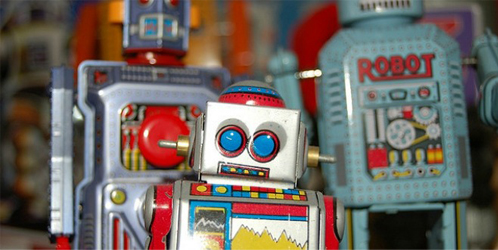
Which Kind of Cyborg Are You?
WIRED

Machines are replacing humans in the thinking process. The field of Cognitive Thinking is a mixture of combining rich data collection (with wide array of sensors), machine learning, predictive analysis, and cognitive anticipation in a right mix. Machines can do “just-in-time-machine-learning” rather than using predictive models and are virtually model free.
The Cognitive Computing concept revolves around few combined concepts:
- Machines learn and interact naturally with people to extend what either humans or machines could do on their own.
- They help human experts make better decisions.
- These machines collect richer data sets and use them in their decision making process, which creates the need for intelligent interconnected devices. This creates a network of intelligent sensors feeding the super brain.
- Machine learning algorithms sense, predict, infer, think, analyze, and reason before they make decisions.
Which Kind of Cyborg Are You?
The field of cybernetics has been around for a long time. Essentially, it is the science (or art) of the evolution of cyborgs. The cyborgs have evolved from assistive cyborgs to creative cyborgs. Not only can they adapt to human situations, but they are also able to learn from human experiences (machine learning), think (cognitive thinking), and figure out (situation analysis) how to help us rather than being told.
Assisting (or mechanical) cyborgs. Cybernetics started with replacing human body parts that were damaged beyond repair. These replacements make assisted living easier. Limb replacements, heart transplants, and kidney replacements all not only make the medical/healthcare costs cheaper in the longer run but also equip humans to continue with their normal lives.
Though the movie “Robocop” popularized the mechanical cyborgs, there is a hypothesis that Queen Vishpala, mentioned in Rigveda from 1000-2000 BC, was the first to be fitted with a “leg of iron” enhancement that would qualify her as the first cyborg. Cybernetics has advanced to such a level now that high performing athletes are able to compete at the professional circuits using such mechanical or assisted fittings. A great example of this would be the now infamous Oscar Pistorius (also known as Blade Runner), a South African sprint runner who competed in the 2012 Summer Olympics.
Intelligent cyborgs. Then came the next category of machines that was popularized by the Terminator movie series. Essentially, these are the thinking machines that hypothesize the concept of machine thinking. In these categories of machines, which are essentially designed to aide and assist the human race, these cyborgs are never implanted in humans. But these are essentially cognitive machines which are built to think, act, and behave like humans. Essentially, instead of inserting elements into humans to make them super humans, we realized we can make the machines to do the work for us.
Adaptive and creative cyborgs (machine learning). These are the category of machines that not only learn about your environment, but also learn about you and adapt to you. This machine learning concept led to a new wave of research which includes “Cognitive Computing”. This is not to be confused with the Tom Cruise movie Minority Report, which is more about pre-cognitive — or almost fortune telling — abilities of three mutated humans with precog abilities. In a nutshell, here is how they are different.
In the old days, super computers were programmed with the expected set of answers/actions based on certain events, and were expected to perform based on the algorithm. These adaptive cyborgs have built-in super intelligence that allows them to learn (hence the term machine leanings) and adapt to the scenario. This is exactly the reason why human kind rose above the food chain of the animal kingdom, by our super context-based thinking abilities.
A popular example of these cyborgs is IBM’s Watson, which outperformed the humans in every single way. But now we are taking that concept everywhere we can — from automobiles, to home sensors, to healthcare, to traffic control, etc.
The field of active cybernetics allowed us to use machines not only with decision making, but also to help you adjust your behavior and your thinking.
The precedent for this comes from Rene Descartes, who in a 1641 book First Philosophy asks a question about reasoning based on senses: “My senses provide me proof that the world exists. I believe in what I see, feel, smell — whether it is real or a dream. How can a real (data) feeling realized by a sensor can be trusted if the sensor cannot be trusted, especially if the sensor is controlled by an evil demon during my dreams” (I am paraphrasing his concept here).
This concept is captured in the movie “The Matrix” with a scene in which the traitor, who is ratting out his friends, is given a juicy steak and while eating it he says, “I know this steak doesn’t exist. I know that when I put it in my mouth, the Matrix is telling my brain that it is juicy and delicious.” It is those kinds of “Forced virtual reality” or forced perceptions that can allow humans to adopt their actions, reasoning, thinking, and decision making process: An induced simulation to make believe the concept or non-realism is real.
In other words, machines will not only out-think humans in the near future, but they also can trick us into make decisions that are planted with their data points.
Andy Thurai is CTO for app security and big data with Intel, and blogs at www.thurai.net/blog. he can be reached on Twitter at @AndyThurai.
This article was originally published in wired on jan, 2014 – https://www.wired.com/insights/2014/01/kind-cyborg/







